In the realm of cutting and sewing – two pivotal areas in garment manufacturing – these advancements have been particularly noticeable. Cutting fabric has seen significant technological evolution. Advanced cutting machines are now at the forefront, ensuring precise and accurate fabric cuts. This precision not only reduces wastage but also conserves time. Robotic arms and advanced cutters, capable of slicing through multiple fabric layers simultaneously, have accelerated garment production rates.
The sewing domain, too, has seen the boon of technology. Modern sewing robots, capable of intricate stitching patterns, are emerging as industry game-changers. Their efficiency and cost-effectiveness are unmatched, as these machines can operate continuously, devoid of fatigue or error.
Moreover, AI has carved out a crucial niche in the garment and textile manufacturing sectors. Systems empowered by AI sift through data, discern trends, and predict market demands. This predictive prowess enables manufacturers to produce garments with higher sale probabilities. Furthermore, AI optimises production workflows, diminishing waste and bolstering the efficiency of manufacturing units.
In essence, automation’s myriad advantages in garment manufacturing, as outlined in this article, underscore a promising future for the industry.
Requirements for Automation
Given the fiercely competitive global textile market, customer expectations are escalating continuously. A primary challenge is the necessity for skilled workers at every phase of garment production. Thus, the integration of sophisticated automated machinery is imperative for amplifying garment output. It is undisputed that automation enhances overall productivity and minimises quality discrepancies, all while reducing manufacturing expenses. To meet the rising demand for top-notch apparel and to ensure cost-effectiveness, it is pivotal to adopt automated machinery and advanced technologies. Let’s now explore the cutting-edge advancements in cutting and sewing technology within the garment sector.
Automation and Robotics in Cutting Machine
Automatic robotic cutting machines have revolutionised the cutting process for various materials and instruments, introducing significant changes to traditional methods while retaining the fundamental principles of material cutting. In the past, cutting was typically executed manually on the ground without the aid of specialised equipment. However, contemporary advancements have brought about a paradigm shift. Modern cutting machines now encompass a comprehensive array of components and features. These cutting systems typically consist of components like a cutting machine, devices and carriage, nesting, and cutter control software, and crossbars, which have a gantry, beam, cutting bridge, flat working surface, and control panels. These are the main advancements made in modern cutting machines. This technology has not only enhanced precision but also increased productivity, making automated robotic cutting machines an essential asset in various industries. Below are some of the major cutting machines and technologies.
• Gerber Auto-Cutting Machine
Gerber’s automatic cutting machine is popular and widely used in the garment industry. It was the first machine developed to cut garment patterns automatically, and this automation has transformed the textile and garment industry. Gerber cutters have special features and highlights like:
• Easy to use and operate.
• It is a type of CAD-CAM machine, where the data is automatically sent to the CAD system.
• Gerber cutters have the special feature of automatic spreading which reduces the time to spread, save energy, save manpower with better quality of work.
• High intelligence that helps and guides for cutting process.
• It is equipped with proper setups, and it runs rapidly and efficiently.
• It has self-adjusting intelligence which assists in improving workflow efficiency and also reduces lead time.
• It automatically adjusts the speed and maintains the quality of cutting for the best first-run output.
• It has the feature of uptime adjustment, where the operator can replace the knife (sharpening stone) within seconds.
• The scanning system of barcodes available with this machine can scan the parameters so that manual entry, file updating, material type, and layer count is not required.
• And lastly this machine reduces total cutting time, idle time, the time between tasks, and total units cut.
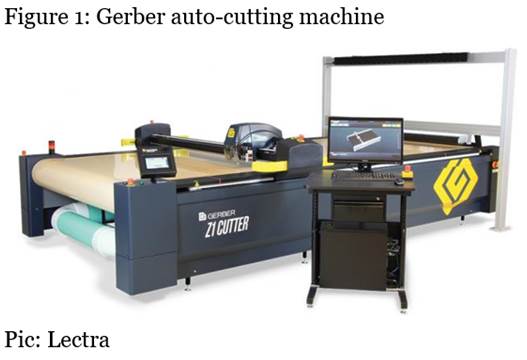
• Laser Cutting Machine
As the name suggests, laser cutting machines are equipped with a laser used for cutting fabric layers. Instead of a traditional cutter, these machines employ a special ray of light known as a laser to cut materials like leather and fabric. Laser cutting machines fall under the category of CAD-CAM systems, where a computer system controls the cutting head. This type of cutting machine is widely used in the garment industry to efficiently cut multiple layers of fabric. The laser in this machine not only cuts the fabric layers but also melts synthetic textiles, resulting in a clean finish on the edges. This addresses the issue of fibre fraying at the edges and allows for precise fabric cutting with intricate designs. The high temperature of the laser facilitates the vaporisation-based cutting process, which utilises a carbon dioxide gas laser.
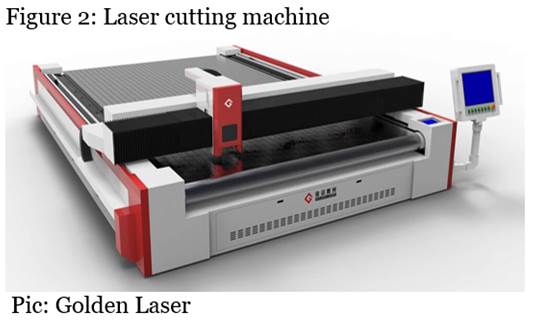
• Water Jet Cutting Machine
The water jet cutting machine works on the principle of high-pressure liquid. A jet of water is used to cut multiple layers of fabrics. This machine is widely used for materials like polyesters, nylons, and other synthetic materials that are not affected by water. In this machine, a fine layer of water jet is sprayed at high velocity through a thin nozzle, which cuts the fabric and fabric layers. This machine generates water with a pressure of up to 60,000 pounds per square inch, which is an exceptionally high-water pressure. This high pressure is what makes it an excellent tool for cutting fabric.
• Plasma Cutting Machine
Plasma cutting was originally developed to meet the growing demand for precise and high-quality cutting standards. However, it is now finding applications in the clothing industry for fabric cutting. This process involves using a high-speed jet with extremely hot ionized gas, specifically Argon, to cut fabric layers. While it allows for faster cutting, it may compromise the quality of the cut. Plasma cutting employs Argon gas, which transforms into plasma at a scorching 30,000 degrees Celsius, to cut one or multiple layers of fabric simultaneously. The nozzle, filled with Argon gas, is used to achieve faster fabric cutting. However, plasma-cutting machines are not commonly used in the apparel industry for cutting fabric. Although these machines are widely used and highly effective for cutting metals and other materials, their extreme heat and energy levels make them unsuitable for delicate textiles like clothing fabrics.
Automation and Robotics in Sewing Machines
The modern evolution of the garment industry underscores the transformative power of automation in sewing production. While electrical sewing machines have been operational for over a century, the persistent challenge for garment manufacturers has been the dependency on skilled operators. This dilemma is not unique to the garment sector; most manufacturing industries require adept personnel to ensure seamless and efficient mass production.
The sewing phase in garment production is pivotal, imparting value to fabrics by metamorphosing them into final products. Introducing industrial robots to this process has proven invaluable, especially in cost-cutting. These robots, coupled with automation, not only enhance production efficiency but also etch a distinct brand perception in consumers’ minds.
Now, let’s delve into the diverse technologies and robotics deployed in the sewing assembly line.
• Robotic 3D Sewing Technology
The cutting-edge robotic 3D sewing technology is redefining the horizons of garment manufacturing, ensuring high-quality output. This innovative technology, pioneered by Philipp Moll GmbH & Co, brings the concept of 3D sewing to the fore. The machine is uniquely designed to manufacture trousers, shirts, jackets and other staple garments using a 3D seam. Beyond traditional garments, this technology is adept at sewing automobile textiles, encompassing items like seat covers and airbags.
The 3D approach empowers manufacturers to produce items with unparalleled efficiency and superior quality. Additionally, it provides a slew of benefits, including a reduction in labour costs and lead time, while simultaneously enhancing productivity.
• Industrial Robot (SEWBO) and LOWRY SewBot
SEWBO and LOWRY SewBot are special robots used in the garment industry. These automated robotic machines are equipped with features for sewing and handling fabric. SEWBO, a robot introduced in 2015, is capable of sewing an entire T-shirt on its own. At the time of its creation, this was a significant achievement, as no robotic machines of this kind existed. These robots can be configured for specific sizes and styles, but reprogramming is necessary when changing the size or style. However, once configured, they can sew complete T-shirts without the need for additional machines or equipment. This type of robotics reduces the need for almost 3-4 machines typically required to sew a single T-shirt.
The LOWRY SewBot was invented in 2012 by a company in the US. It is a robot primarily designed for making clothes and can handle different fabric sizes and shapes. These SewBots now fall into the category of advanced technology, utilising computer vision and artificial intelligence to work with fabric like humans do. They can perform various sewing activities required for making clothes, including automatic fabric cutting, sewing, labelling, and inspection. All of these functions are controlled through a touch panel integrated into the machine.
These automated sewing machines offer a variety of features, such as different stitching patterns and the ability to stop the needle in an up or down position, making them highly versatile for clothing production. Both machines can reduce the amount of work required by humans by 50-70 per cent. In the US, it costs $7.48 to make a denim shirt using human labour for sewing, but with robots, it costs only $0.33. Robots are also capable of producing a large number of clothes quickly. For example, in just 8 hours, they can produce 669 T-shirts, which is much faster than what humans can achieve. In China, there have even been tests where robots could produce one T-shirt every 22 seconds, with the aim of producing 800,000 T-shirts a day for Adidas. This represents a significant achievement in the field of engineering. Many R&D teams from various machine manufacturing companies are working on similar automation technologies.
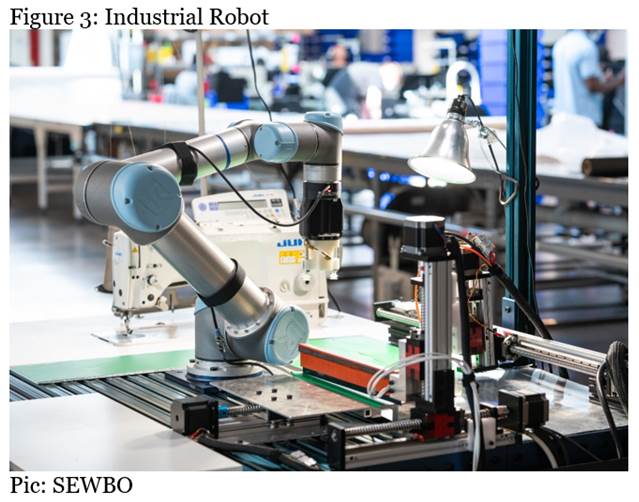
• Automated Binding, Button and Button-hole Sewing Machine
In the global market, the attachment of accessories like binding, buttons, buttonholes, and others is facilitated by vital textile attaching and joining technology. Several suppliers, such as Juki, Jack, Duerkopp, Pegasis, and others, manufacture various semi-automatic sewing machines that are commercially available to offer advanced services and technologies to apparel manufacturers. For instance, Juki offers sewing machines that are capable of automatically sewing buttons and creating buttonholes. Rimac, on the other hand, has come out with an automatic machine designed to neatly finish the curved corners of items like bedding and floor carpets. Additionally, the Duerkopp Adler sewing machine is used for sewing double-welt pockets. These machines make various sewing tasks much easier and more efficient.
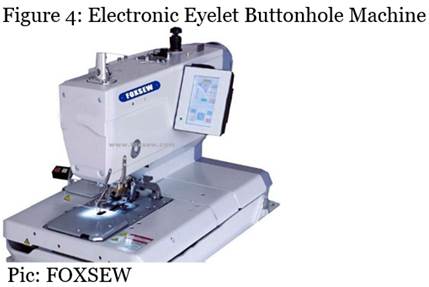
• Automation in Surging Machine
Surging means a simple lock operation performed by the machine. Mostly surging is done for the knitted garments, to prevent threads from coming out of the fabric. This operation secures the edges of the fabric. Automation in surging plays a vital role in stitching the trousers. In this type of specialised machine, a trouser pattern should be provided into the system, then it will automatically overlock both the edges of the pattern. When the surge is finished, the machine inserts the patterns on the handle. In traditional types of machinery, fabric edges are sewn separately in the sewing process, but in this automatic surging process, it is put together in a single operation. So, it saves a lot of energy, time, and effort.
• Automatic Computer-Controlled Cycle Machine
In the apparel industry, cycle stitching is very popular. However, this operation can now be completed within minutes with the help of an automatic computer-controlled cycle machine. This machine comes equipped with a small box panel and clamp that are used for the respective data entry and securing the pattern in place. It operates as a semi-automatic system, where certain sewing characteristics such as length, width, stitching path, and pattern placement are taken care of. As a result, the machine is able to sew the fabric pattern efficiently.
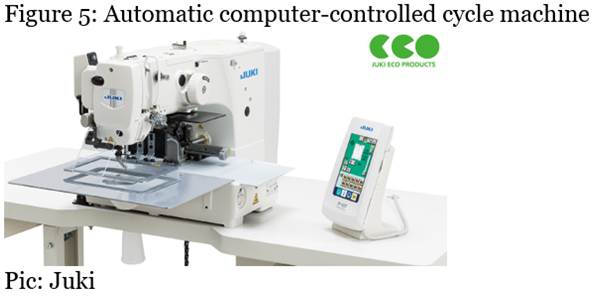
• Automated Pocket-Attaching Machine
The production of trousers, jackets, T-shirts, and coats has traditionally involved critical sewing operations, especially when it comes to creating single or double welt pockets. However, this challenge has been effectively addressed through the implementation of automatic pocket-attaching machinery. This type of machine reduces the need for nearly five to six operators. Only one operator is required to manage the machine and the placement of fabric patterns. It can sew together three to four fabric layers and perform four to six different operations as needed. After completing all the operations, single-welt or double-welt pockets can be manufactured within one minute. This automated pocket-attaching machine streamlines the production process.
• Automated Belt-Loop Attaching Machine
In the traditional manufacturing of trousers or jeans, the belt loop attachment is considered a bottleneck area where the operator has to perform three different tasks, producing the belt loop, cutting that loop, and then attaching that loop at the respective position of the garment. But now this task is done with the help of a single machine. The automatic belt loop attaching machine allows to shape and size the belt loop while stitching. This machine performs all the above activities simultaneously. This kind of automation saves time and labour costs while minimising errors.
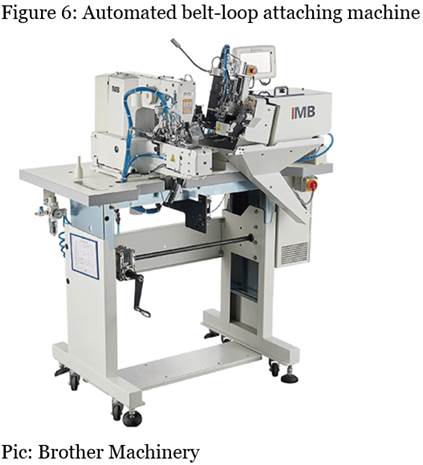
• Sewing Machine with Automated Bobbin Changer
Among all the types of machinery mentioned in this article, there is a special kind of sewing machine that comes equipped with an automatic bobbin changer. This machine operates on the principle of checking and replacing the bobbin during sewing. The machine checks the remaining thread in the bobbin, and at a specific point in time, it replaces it with a filled one using a robotic catcher. Once the current bobbin reaches a certain level of remaining thread, it is automatically replaced with a filled bobbin. The first automatic bobbin-changing machine was developed in 1995. The auto bobbin changeover feature of this machine not only enhances productivity but also reduces stitching problems and alleviates worker fatigue.
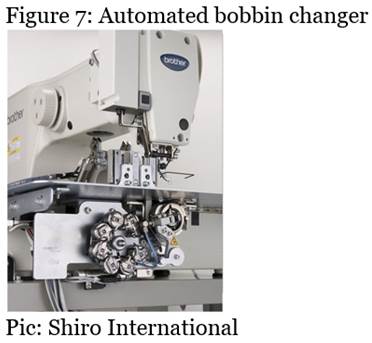
• Buttonhole Indexer
This machine is fully computer-controlled and is referred to as a buttonhole indexer. It comes equipped with a single-panel box where one can input and control data. It takes into consideration factors such as the actual distance between the two holes, SPI (stitches per inch) during stitching, the type of buttonhole, and other necessary parameters. This special kind of machine significantly enhances productivity and improves the quality of buttonholing.
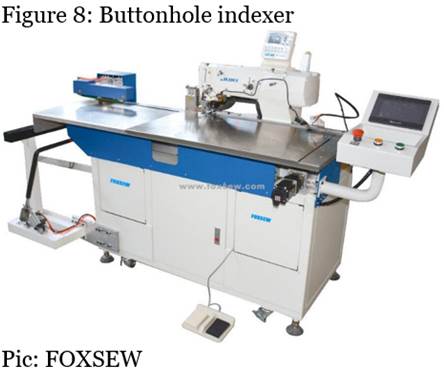
Benefits of the Use of Cutting and Sewing Automation
As discussed in all the types of cutting and sewing automations, garment manufacturing companies enjoy numerous benefits that have a significant impact on their productivity, production efficiency, overall performance, and organisational profitability. Here are some additional benefits:
• Quality improvement: Automation in cutting and sewing leads to reduced defects in garments because human intervention is eliminated. This results in higher product quality with fewer defects, improved workflow, and reduced Defects Per Hundred Units (DHU).
• Performing jobs with high capability: Automation possesses the capacity to execute multiple tasks concurrently. Traditionally, the apparel industry has been reliant on highly skilled labour. Yet, owing to intensifying competition, a growing number of garment manufacturers are pivoting towards incorporating electronic devices, gadgets, and automation. While conventional manufacturing methods leaned heavily on expert manpower for intricate tasks, contemporary automation and refined techniques now facilitate the accomplishment of these objectives with greater ease and efficiency.
• Increase in productivity: Automation can boost the productivity and efficiency of the production process by as much as 70 per cent. Reliance on manual labour often introduces the risk of errors, potentially leading to diminished quality and efficiency. Factors such as human fatigue and the necessary breaks taken by workers can further decrease individual output, subsequently affecting the broader organisational productivity. By minimising the dependence on manpower, automation not only amplifies productivity but also aligns more closely with organisational goals.
• Reduction of product variability: The involvement of workers in production activities can lead to product variability. With automation, the variations within the same product category across different batches are minimised, leading to higher quality standards and a reduction in the need for rework activities.
• Increased inventory turnover: Automation leads to increased productivity within the organisation, resulting in higher total material turnover. In manual operations, raw materials, cut components, and semi-finished components often wait longer to be converted into the final finished garment. Therefore, automation can improve inventory turnover.
In addition, there are other benefits of automation implementation in the garment sector, including increased production of goods in less time, high-quality garments, reduced labour costs, shorter working hours, increased demand for skilled engineers, and more.
Conclusion
The garment industry is currently undergoing a remarkable revolution driven by advancements in cutting and sewing technologies. The integration of robotics and artificial intelligence has brought significant change to the way clothing is manufactured, making the entire process faster, more efficient, and less reliant on manual labour. Automation has played a pivotal role in various facets of the garment production process. In cutting technology, sophisticated machines like auto-cutting machines, laser cutting machines, water jet cutting machines, and plasma cutting machines enhance precision, increase productivity, reduce waste, and save valuable time with better-quality cutting. On the sewing front, automation and artificial intelligence have introduced innovations like robotic 3D sewing technology, industrial robots such as SEWBO and LOWRY SewBot, and automated machines for tasks like button attachment, pocket creation, belt loop attachment, and more. These technologies have not only reduced the reliance on human labour but have also significantly improved the speed and efficiency of garment production. The different benefits brought by automation include improved product quality, the ability to handle tasks beyond human capabilities, increased productivity, reduced variability among products, and enhanced inventory turnover. In summary, automation is reshaping the garment industry, making it more competitive and adaptive in a rapidly changing global marketplace. Looking ahead, there is great potential for further advancements in the global textile and garment industry.





_Big.jpg)





Comments